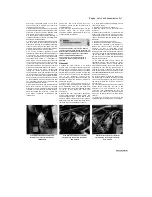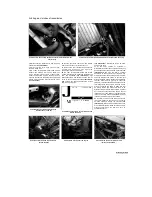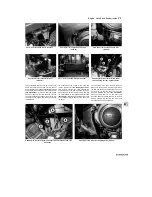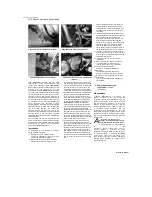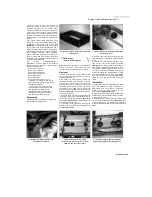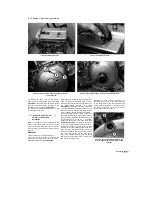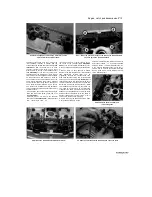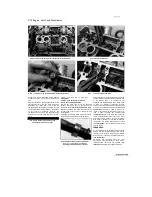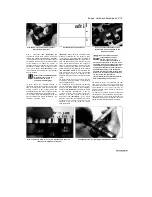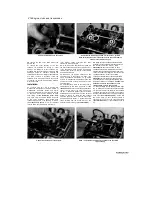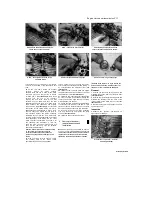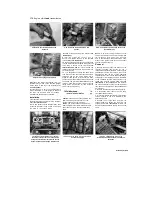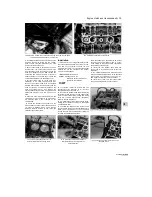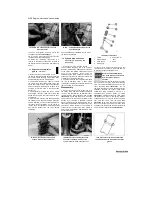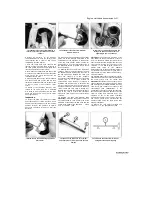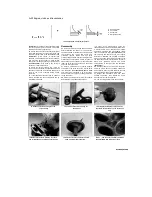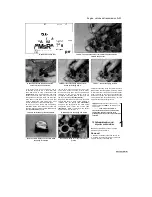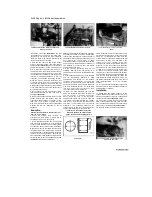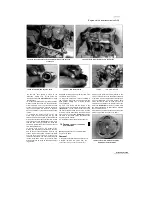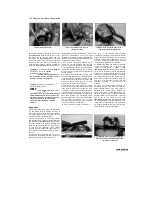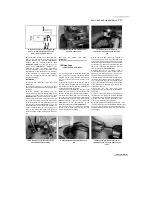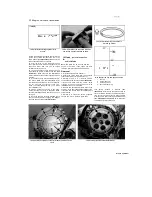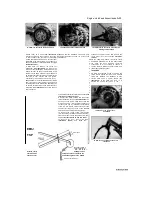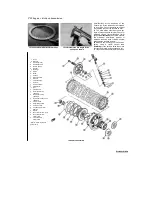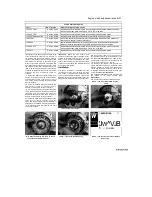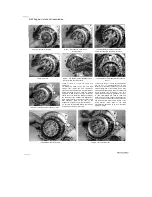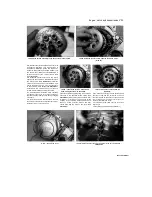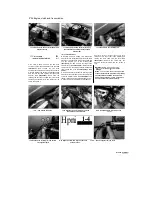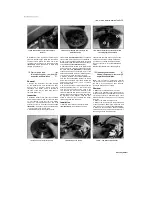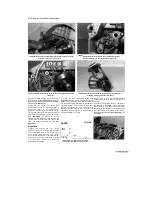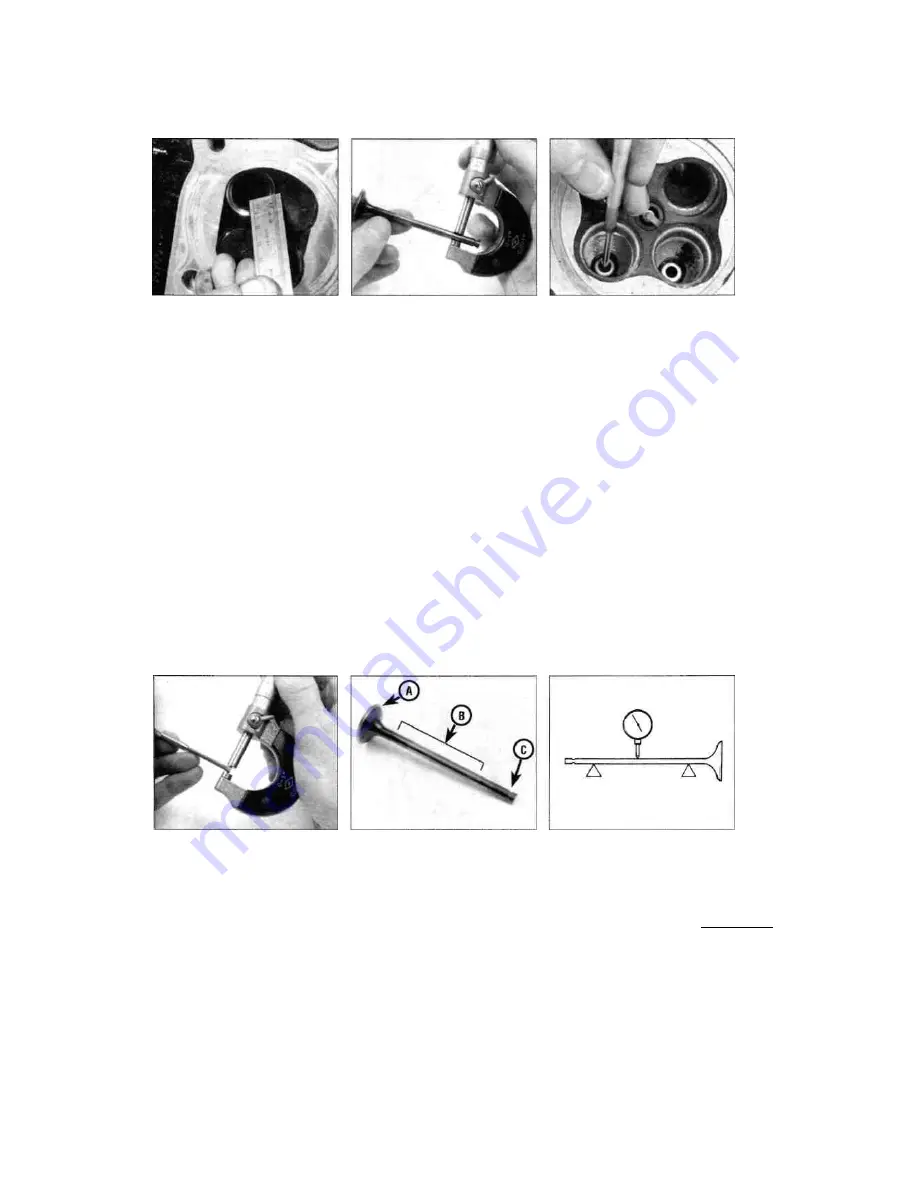
Engine, clutch and transmission 2«21
12.13 Measure the valve seat width with a
ruler {or for greater precision use a vernier
caliper)
6
Repeat the procedure for the remaining
valves. Remember to keep the parts for each
valve together and in order so they can be
reinstalled in the same location.
7 Once the valves have been removed and
labelled, pull the valve stem seals off the top of
the valve guides with pliers and discard them
(the old seals should never be reused).
8 Next, clean the cylinder head with solvent and
dry it thoroughly. Compressed air will speed the
drying process and ensure that all holes and
recessed areas are clean.
9 Clean all of the valve springs, collets, retainers
and spring seats with solvent and dry them
thoroughly. Do the parts from one valve at a time
so that no mixing of parts between valves
occurs.
10 Scrape off any deposits that may have
formed on the valve, then use a motorised
wire brush to remove deposits from the valve
heads and stems. Again, make sure the valves
do not get mixed up.
Inspection
11
Inspect the head very carefully for cracks
and other damage. If cracks are found, a new
head will be required. Check the cam bearing
surfaces for wear and evidence of seizure.
Check the camshafts for wear as well (see
Section 8).
12.14a Measure the valve stem diameter
with a micrometer
12
Using a precision straight-edge and a feeler
gauge set to the warpage limit listed in the
specifications at the beginning of the Chapter,
check the head gasket mating surface for
warpage. Refer to
Tools and Workshop Tips
in
the Reference section for details of how to use
the straight-edge.
13 Examine the valve seats in the combustion
chamber. If they are pitted, cracked or burned,
the head will require work beyond the scope of
the home mechanic. Measure the valve seat
width and compare it to this Chapter's
Specifications
(see illustration).
If it exceeds the
service limit, or if it varies around its
circumference, valve overhaul is required. If
available, use Prussian blue to determine the
extent of valve seat wear. Uniformly coat the seat
with the Prussian blue, then install the valve and
rotate it back and forth using a lapping tool.
Remove the valve and check whether the ring of
blue on the valve is uniform and continuous
around the valve, and of the correct width as
specified.
14
Measure the valve stem diameter
(see
illustration).
Clean the valve guides to remove
any carbon build-up, then measure the inside
diameters of the guides (at both ends and the
centre of the guide) with a small-hole gauge
and micrometer
(see
12.14b Insert
a
small-hole gauge into the
valve guide and expand it so there's a
slight drag when it's pulled out
illustrations).
The guides are measured at the
ends and at the centre to determine if they are
worn in a bell-mouth pattern (more wear at the
ends). Subtract the stem diameter from the valve
guide diameter to obtain the valve stem-to-guide
clearance. If the stem-to-guide clearance is
greater
than
listed
in
this
Chapter's
Specifications, the guides and valves will have to
be renewed. If the valve stem or guide is worn
beyond its limit, or if the guide is worn unevenly,
it must be renewed.
15
Carefully inspect each valve face for cracks,
pits and burned spots. Check the valve stem and
the collet groove area for cracks
(see
illustration).
Rotate the valve and check for any
obvious indication that it is bent. Using V-blocks
and a dial gauge if available, measure the valve
stem runout and compare the results to the
specifications
(see
illustration).
If
the
measurement exceeds the service limit specified,
the valve must be renewed. Check the end of the
stem for pitting and excessive wear. The
presence of any of the above conditions
indicates the need for valve servicing. The stem
end can be ground down, provided that the
amount of stem above the collet groove after
grinding is sufficient.
16 Measure the valve margin thickness and
compare it to the specifications
(see
12.14c Measure the small-hole gauge with a
micrometer
12.15a Check the valve face (A), stem (B)
and collet groove (C) for signs of wear and
damage
12.15b Check the valve stem for runout
using V-blocks and a dial gauge
Scaned by Stalker
Содержание XTZ750
Страница 174: ...UNREGISTERED VI ScanedbyStalker UNREGISTERED VI ...
Страница 207: ...Wiring diagrams 9 29 _____Scaned by Stalker 5 l 6o Cxj fi I JICM ...
Страница 208: ...UNREGISTERED VI 9 30 Wiring diagrams UNREGISTERED VERSION 01 ONREGISTEREDVI Scaned by Stalker ONREGISTERED VERSION 0 ...
Страница 209: ...I UNREGISTERED VI Wiring diagrams 9 31 ____ Scaned by Stalker UNREGISTERED VERSION OF PICTURE DESK ...
Страница 210: ...9 32 Wiring diagrams Scaned by Stalker ...
Страница 211: ...XTZ750 gauge Starter circuit Neutral Starter cut off relay switch rnotor ...

